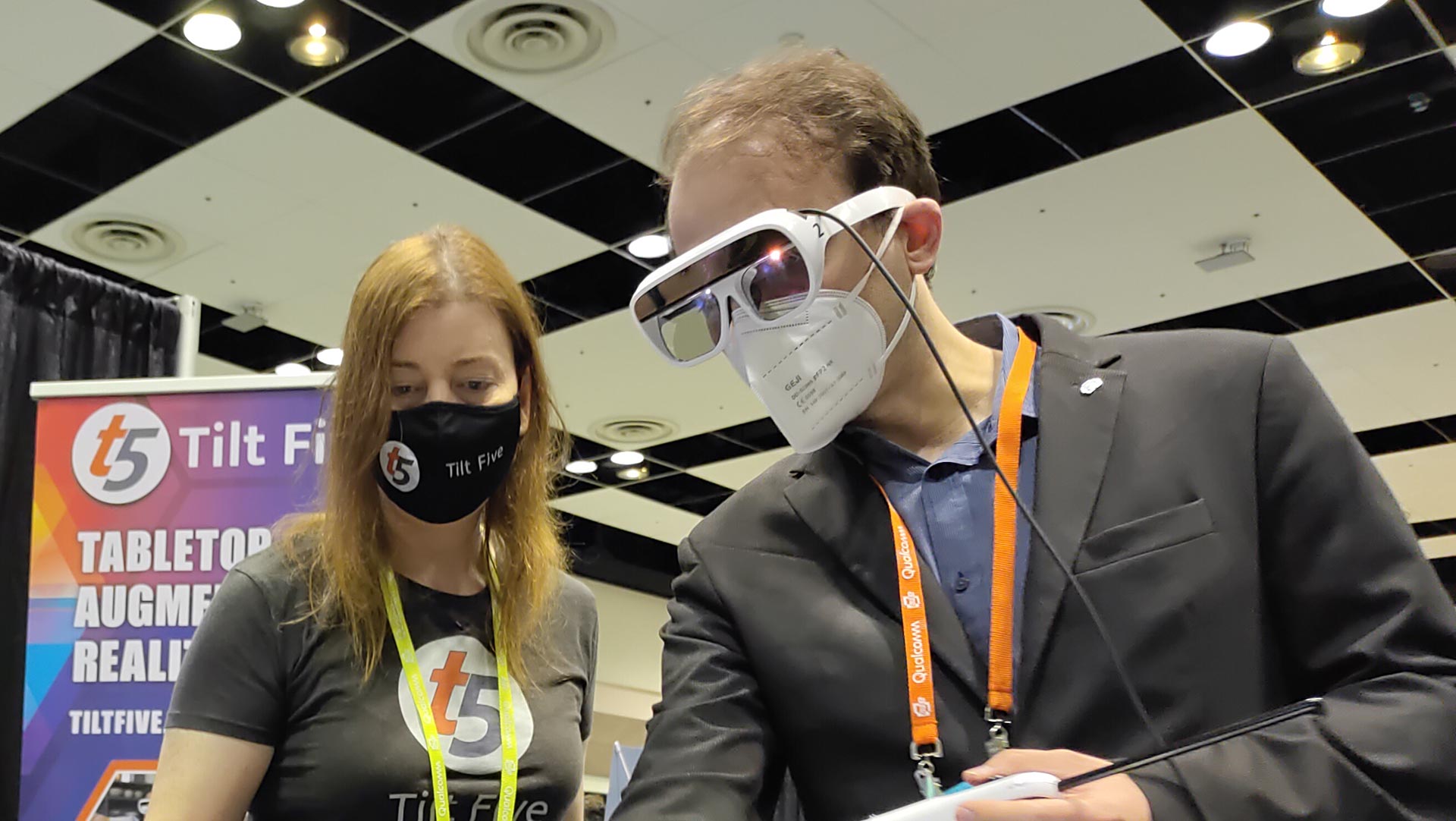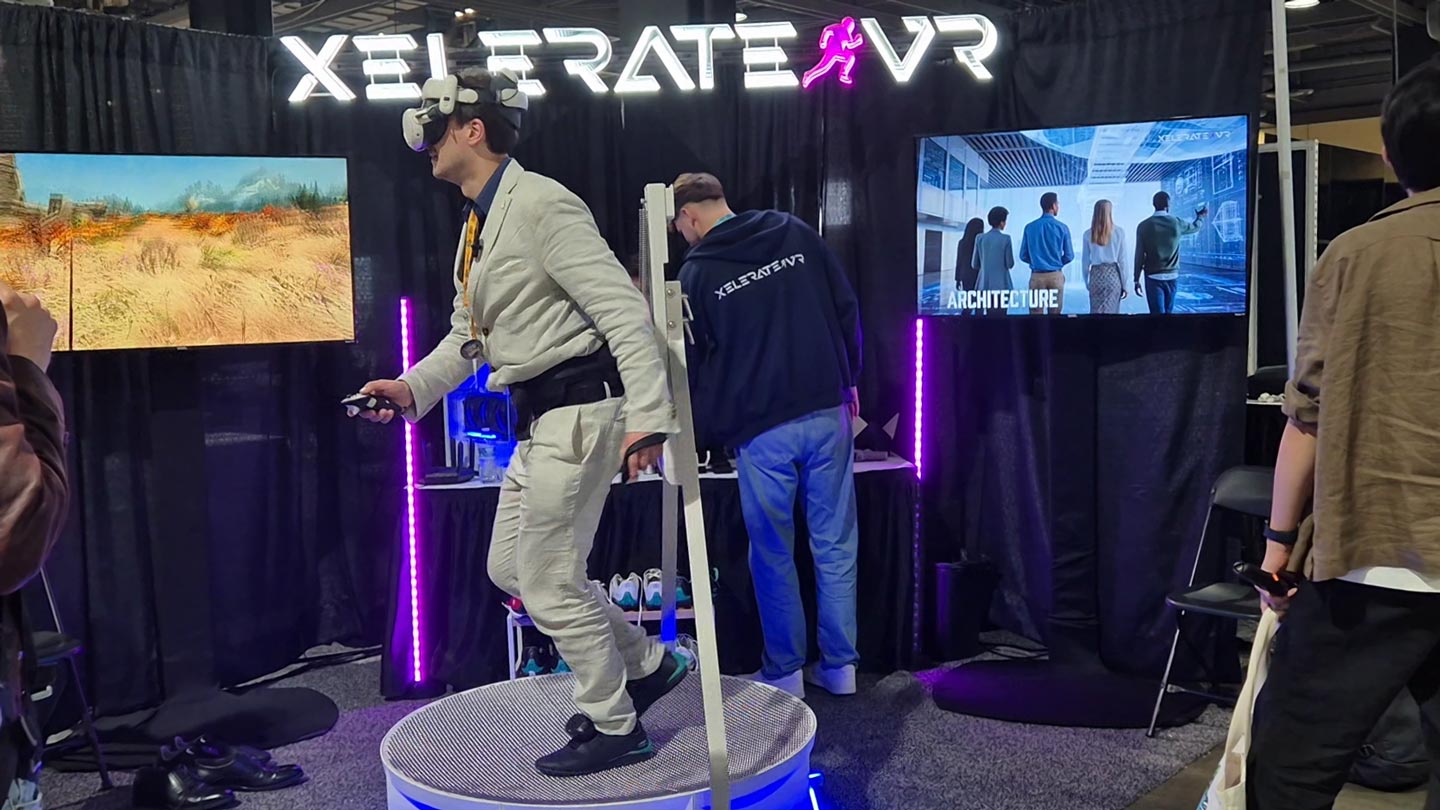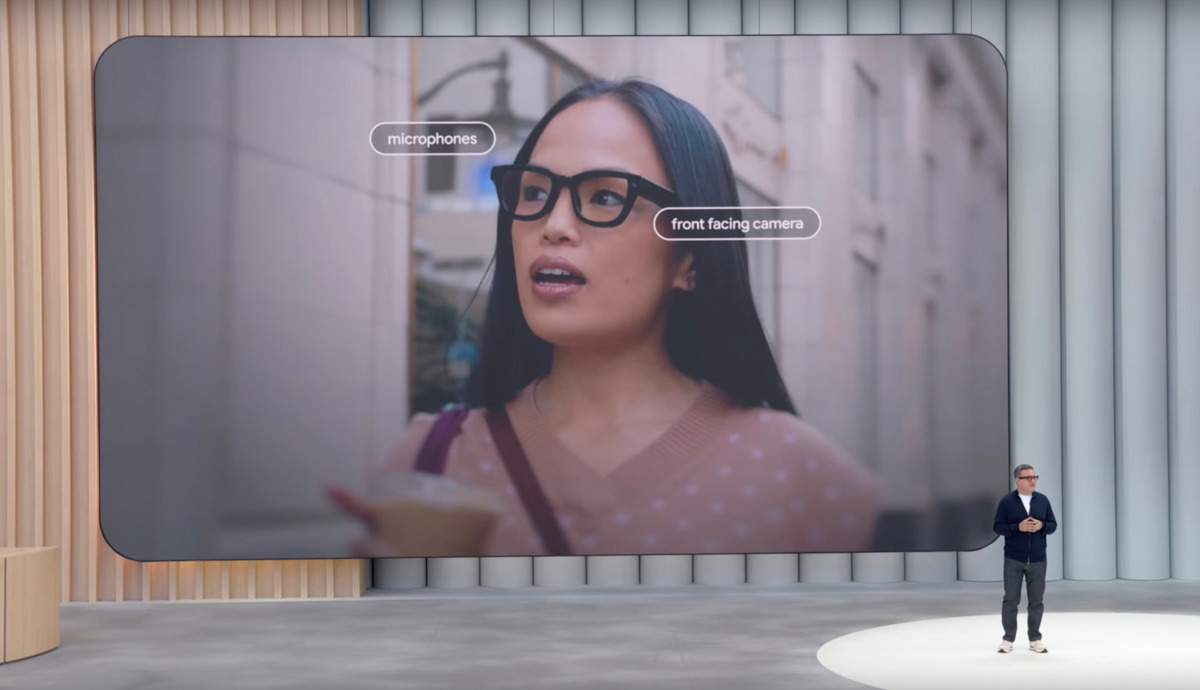Tilt-Five hands-on: very interesting AR glasses for board games
I’m finally finding some time to write a few articles that I have left back from my journey to Silicon Valley to attend AWE US. During my stay there, I had the incredible occasion of meeting Jeri Ellsworth at her office and try hands-on the Tilt-Five glasses. Here you are my experience with them!
Tilt Five
Tilt Five is a startup working on eponymous AR glasses that are focused on board games. It has been founded by Jeri Ellsworth, a former Valve employee that worked directly with Michael Abrash in the lab that was experimenting with AR and VR before Oculus was even a thing. She’s a great knowledge of the technology, so she has been able to design a pair of glasses that have some genius solutions that no other glasses have.
The idea behind Tilt Five is creating a pair of glasses that are not general-purpose ones, like HoloLens or Magic Leap: Jeri knows the technology is not ready yet. And in fact, these AR glasses, while very intriguing, are very limited in their functionalities (e.g. the FOV is very little). So she’s opted for offering glasses that are devoted only to one purpose but do it very well. Since she’s nerdy, she picked up tabletop games as the main field of application: Tilt Five is so amazing to play board games, and also whatever other application that must run on a limited planar surface.

Thanks to this focus on purpose, the glasses feature intriguing specs. They’re very lightweight (around 100g), also because they must be connected to a PC or a phone, so they don’t need onboard computational units. The FOV is 110 degrees, much superior than the one of all the other AR headsets (and in part even of some VR headsets!), with 85% of light efficiency of the lenses that make them very transparent.
Also how they work is interesting: there have not the usual waveguide displays that create one image for the left eye and one for the right eye like the HoloLens, but there is a projector that casts the light representing the virtual elements outside the glasses (so NOT towards your eyes, but in the opposite direction), then this light gets reflected by a special board made in a special reflective material that makes the rays return back in the same direction they were cast, so they arrive back to the glasses, and so to your eyes. The left and right images get separated thanks to different polarization of the left and right lenses, so each eye only sees the image it must see, and you can see 3D elements popping out from the board.

You may wonder why there is all this hassle about projecting light and making it bounce again back: well, if you do it this way, the actual light rays are coming from the board itself, so your eyes correctly identify the source of the 3D elements on the board location and you are able to focus on them. You don’t have a fixed focal plane, but your focal plane becomes where the board is in, wherever you are in the room.
Tilt Five of course needs this board made in a special reflective material to work, and you can see 3D elements only where is this board. Luckily, the board is made in a modular fashion, so that you can also create a bigger version of it.
The glasses perform positional tracking thanks to little black dots that are placed on the border of the board. Without those dots, it can’t track its position. The board is fundamental also for this.
Tilt Five support a controller, that looks like a gas lighter, through which you can either point and click elements on the game, or you can also just use it as a standard gamepad.

Tilt Five managed to launch a successful Kickstarter campaign where the company collected $1.7M to build the glasses. When I visited them in November 2021, they were in the process of building the units for the first backers. Let me tell you about my experience with Jeri and with the glasses. I’ll start talking about my experience with her to tell you some fun stories, but if you want to jump directly to my opinion on the glasses, go straight to the “Tilt Five glasses first impressions” paragraph.
Meeting Jeri

Meeting Jeri Ellsworth in real life has been an experience as interesting as trying the glasses. She’s an amazing person, and when I had to leave the office, she gifted me a hug and a Tilt Five T-shirt! She showed me the office around, she gave me food, and told me very intriguing stories of her working life. I enjoyed all my time with her.
If you have to meet her, I anyway suggest you bring some chocolate to eat to fight the accompanying feeling of inferiority that you may develop: I mean, she’s so bright she may blind you. The first thing we did when we started our tour was having a pinball match together. Tilt Five offices are full of pinball machines, and I wasn’t using one probably since 15 years ago, but I wanted to have some fun with them because I think they are cool. Jeri agreed to have a match one against the other. I launched my first ball, I made some points, and after like 30 seconds, I lost. It was her turn, so she took control of the machine and started playing: the ball started jumping everywhere, scoring a lot of points, freeing other balls, that started moving all together, activating functions in the machine that I didn’t even know if they were scripted by its developer, or if Jeri was reprogramming it on the fly by flashing its firmware with lasers coming out from her eyes. At a certain point, she even started playing by looking me in my eyes and not focusing on the pinball anymore, and she kept making lots of points… she was part of the pinball at that point. I suspected that she could even start playing it with the feet, but probably didn’t want to impress me that much.

The pinball match went on in a similar fashion for various minutes, and at the end of the first ball I was already depressed, but the humiliation come with the final score after the match was over. It was something like: Tony 56,000 points; Jeri 2,743,000.
Then she took me to enjoy some of the cool retro hardware devices she has in her collection, like the Nintendo Powerglove and Virtual Boy (that I had never worn before!). I envied them so much, but I was happy she made me wear them.

She also showed me the amazing new hardware she got, like the Steamdeck. She told me about when she met Bill Gates, Mark Zuckerberg, and of course Gabe Newell that she knows from when she worked at Valve. She took me to visit the lab of the office and showed me some parts of the glasses and tried to explain to me how all the optical parts worked, but I think I grasped the same quantity of information that I usually understand when I watch a movie in Chinese. She kept telling me that the concepts were easy, but I think we two have different levels of “easy” 😀

After all of this, I was thinking “Ok, she’s smart with hardware, she knows important people, she’s good at pinball, but at least I have still an edge: I’m a developer, and can create applications for her glasses, something that she can’t do”. This was the moment she took out a Laptop and said, “Oh, this is a game that I’m developing in Unity for Tilt Five…”

No way… Jeri is too amazing to handle.
Tilt Five offices
Tilt Five new offices are quite big and modern. I appreciated having a tour inside them and seeing many gaming references, retrogaming devices, and other fun stuff scattered around them. If you are nerdy like me, you would surely love some gems, like this fridge:

It’s also interesting that there are some rooms that act as the lab for the glasses. The startup experiments in loco on how to build the glasses, and for instance has there the machines necessary to calibrate the optics of the headset. The reasoning is to have a local laboratory where they experiment on how to build and also how to improve the glasses, so that when they find solutions, they can then make the factories in the other part of the world implement these processes at scale, building thousands of units. Of course, the R&D of a company must be local, it can’t be performed in Chinese factories, which instead should only receive exact instructions on how to build stuff. The Tilt Five team showed me some of the machines necessary to calibrate the various parts of the headset, and I found the process very interesting. They also made me see the evolution of the internals of the glasses, and some old and new prototypes. It was clearly possible to see how there have been many experiments to evolve the device over time.

I also met some other Tilt Five employees during the tour, and they were all nice people (special mention to Amy, Stephanie, and Joe… that I was happy to finally meet in person!). It seems a good place where to work in.
Tilt Five glasses first impressions
(Notice: as I always say in this occasions, I have just tested the glasses for some minutes at Tilt Five offices and on AWE showfloor, so this can’t be a complete review, but just a first impression article. Furthermore, my test happened in November 2021, and now I guess the glasses had some evolution. Keep this in mind while you read this article).

Time to talk about the glasses! The first impression that I got when I wore them was that they are very lightweight and very “transparent”. As I told you before, the light-transmitting efficiency of Tilt Five lenses is around 85%… this means that 85% of the light coming from the environment around you manages to arrive at your eyes. For a comparison, the upcoming Magic Leap 2 has a 22% maximum efficiency… it’s like a quarter of it! Having Tilt five lenses in front of your eyes is almost like not having them, while the other glasses make everything darker.
As for the comfort, it was good because the glasses are very lightweight, but it needed some improvements: they were a bit uncomfortable on my ears, and over time they had the tendency of becoming warm on the forehead and noisy because of the fan. Jeri told me that they were working on fixing these issues, and hopefully, they did that.

The visuals were cool, especially for their “3D effect”. If you remember, in my review about CREAL prototype AR glasses, I told you that lightfields are cool because they make the 3D elements appear “more 3D”, more realistic, with a better sense of depth than the one you have on traditional glasses. Here there is a similar effect, not perfect like the one of lightfields, but somewhat similar. And it is easy to understand why: since the light rays come (reflected) from the board, your eyes have the focal point on the board, so if the virtual elements are visually at a similar depth of the one of the board, your virtual elements are in perfect focus wherever you are in the room, and so your eyes can fully appreciate their depth. After having tried CREAL and TiltFive, I can assure you that 3D virtual elements that are on focus have a level of realism that virtual elements put all at the same fixed focus point can’t even dream of. But it’s difficult to explain why… my best explanation is that “the 3D is more 3D”, which means that you perceive better the depth of the objects, and so they appear more realistic. I was literally amazed by this effect, that no other AR glass ever gave me.

The quality of the visuals, in general, was also quite good, but it was not perfect: the colors were a bit washed out, the holograms were a bit transparent (like in all AR headsets), and the pixel density was not super-crisp. These glasses have a wide FOV, and this was another pro they have since I could interact easily with all the elements in the tabletop even if I was close to the board. Having the peripheral vision is great to keep the immersion high… even if since you have to be focused on watching the board, you notice this advantage a bit less because you don’t have virtual elements all around you. The FOV anyway also causes the drawback of the not-high pixel density: two 720p displays that must cover 110° of FOV show their limitations. I also noticed that the visuals slightly blur if I move away in a distant position from the board.
Another cool trick of Tilt Five is that it makes easy to occlude virtual elements with your hands: since your hands are not made of the special reflective material of the board (or at least, I hope so), they don’t return back the light rays of the virtual elements that should be in that part of the board, and so you don’t see those regions of virtual elements and just your hands. The same holds for the controller, and this increases the realism.
And for some optical magic that I have not understood, even when you stop the application, the glasses can still let you see the last frame that was projected on the board. If you move around, it distorts, but it is cool anyway.
The visuals of Tilt Five truly intrigued me, and while the board is what gives them the magic, it is also its greatest limit. When you see those believable holograms on the table, you would like to see them with the same “3D effect” in all the room around you, but it is not possible, because you can only see the virtual elements on the board. Even more, you can only see virtual elements where is that reflective material: so if you have a tall tower on the board, you can’t see it all, but only the portion of it that falls in the region of the reflective material that you see from your eyes’ point of view. For instance, if you look at the board from the side, with the eyes at its same height, where you don’t actually see the board surface, you see no augmentation, because from your point of view there is no surface that can reflect the light rays.
And this feels truly limiting, because it’s like you just have one window to another reality, and you can access it only through that window. And again, that window is very cool: on the AWE show floor there was a partner company called Cavrnus that showed me a virtual satellite on top of the board, and when I complained about the fact that I couldn’t see it completely because part of the model was above the board and so didn’t fall in the magical region, the employee took a piece of cardboard covered in that special reflective material and put it perpendicularly at the other side of the table, so that the hologram became fully visible to me, and it was magical seeing the object coming to life.

He also started moving this additional board, and wherever the board was, I could see objects coming to life, and it was so cool, it was like having a moving window to a separate reality. I see also some possible artistic applications for this concept. But I mean… while this is cool, it feels a bit limiting because it’s just a window.
And the limitations are even more because the positional tracking of Tilt Five is possible only thanks to the black circles around the board, so also the tracking depends on you looking at the board. You have to be careful to always keep enough circles in your field of view, looking down, or the tracking gets lost. But at least, since these markers are lit with IR light by the glasses, they can also be detected in low light conditions.
I told Jeri about the limitation of using the board, but she told me that it is how the system has been designed, and its purpose is to work on tabletop games, so the board is actually a good thing. Also, without the board and its special material, the magic of the 3D elements would have not been possible.
I played a few games with the controller, and they were all nice. It got me a moment to get used to the controller and how I had to use it (it can be used to point at stuff, or you can just hold it horizontally as a gamepad, depending on the game), but I had fun.

As a developer, I asked Jeri about the SDK of her gadget, so she opened Unity and showed me that the integration basically just requires you to import the package and add a prefab in the scene, so it’s very easy to port your existing tabletop game to Tilt Five. If you are a developer and you have a game that already works on a planar surface, I would suggest you think about porting it, also because Tilt Five can support you in launching your game on its platform.
Having the board for a developer is actually an advantage because when you build a game for Tilt Five, you know that all users will be in the same conditions: same glasses, same board, so it is less likely that your application may have unpredicted behaviors. Also, since the glasses are light and transparent, you can keep them on all the time while you develop, since you can still see your keyboard and your screen, and this makes development times faster. With a Quest instead, you have to continuously put on and off the device.
Final opinion
Tilt Five glasses are overly cool, and so are the people of its company. The glasses have been designed to be perfect for just one use case, and I think that for that exact use case, they work very well: the visuals pop out very well from the board, and the augmentations are the most believable I have seen on an AR glass until now. Many people can play around the table at a game all together, having fun in a new and innovative way. The technology is so interesting that I would like to see it applied to a more general-purpose setting, that it could break the barrier of the board, but it is not possible. I think we’ll have to wait for the usual “5 to 10 years” that we always love to mention to have this magic happen everywhere around us.
In the meanwhile, I wish Tilt Five the best of luck in improving its production processes (I know it had some delays because this period is pretty complicated to build hardware) and invite you all to check out the Tilt Five website if you have not done it yet to discover more about this interesting gadget!
Disclaimer: this blog contains advertisement and affiliate links to sustain itself. If you click on an affiliate link, I'll be very happy because I'll earn a small commission on your purchase. You can find my boring full disclosure here.




